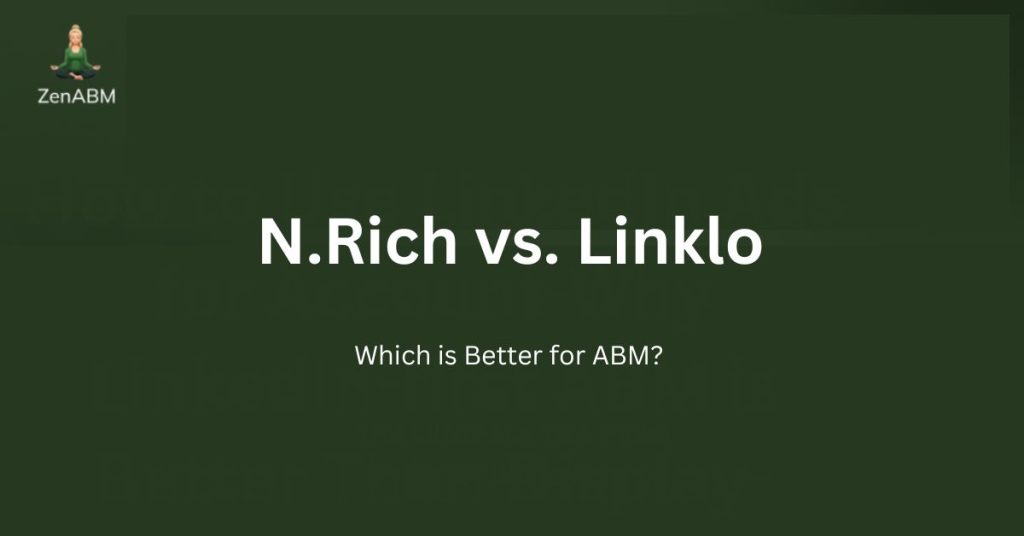In this guide, I break down how N.Rich vs. Linklo differ on features, pricing, and where they fit in an ABM stack, so marketing and sales can see which one suits their ABM motion.
I also show how ZenABM can act as a lean, LinkedIn-first alternative or serve as a complementary layer due to its unique features.

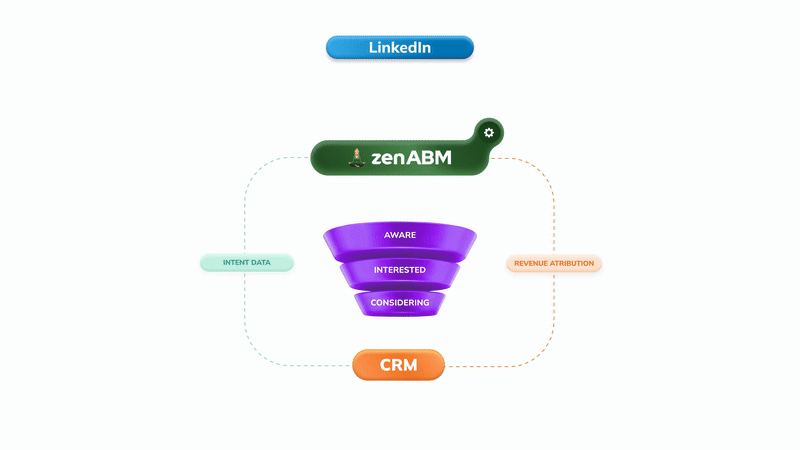
N.Rich vs. Linklo: Quick Summary
In case you’re short on time, here is the snapshot:
- N.Rich is an intent-driven ABM execution layer with its own DSP, ICP builder, and programmatic plus LinkedIn campaigns for mid-market and enterprise teams.
- Linklo is better suited to LinkedIn-centric marketers who want tighter control over campaigns, budgets, and account-level engagement without a heavy programmatic layer.
- N.Rich shines when you need intent scoring, dynamic target lists, and opportunity attribution wired into an ABM playbook.
- Linklo fits teams that want to squeeze more performance out of LinkedIn with scheduling, audience tuning, and practical reporting rather than a full intent plus DSP stack.
- A third option: ZenABM gives account-level LinkedIn ad engagement, engagement to pipeline dashboards, account scoring, ABM stages, CRM sync, first-party qualitative intent, automated BDR assignment, custom webhooks, an AI chatbot, and job title level engagement tracking, starting at $59 per month.
N.Rich Overview: Key Features, Pricing, and Reviews
N.Rich presents itself as an agile ABM execution layer for mid-market and enterprise teams, built on top of a B2B DSP with intent, ICP, and ABM workflows.
Key Features of N.Rich
Core N.Rich capabilities for ABM include ICP building, intent scoring, programmatic campaigns, and account-level analytics.
Dynamic ICP & Target Account Lists
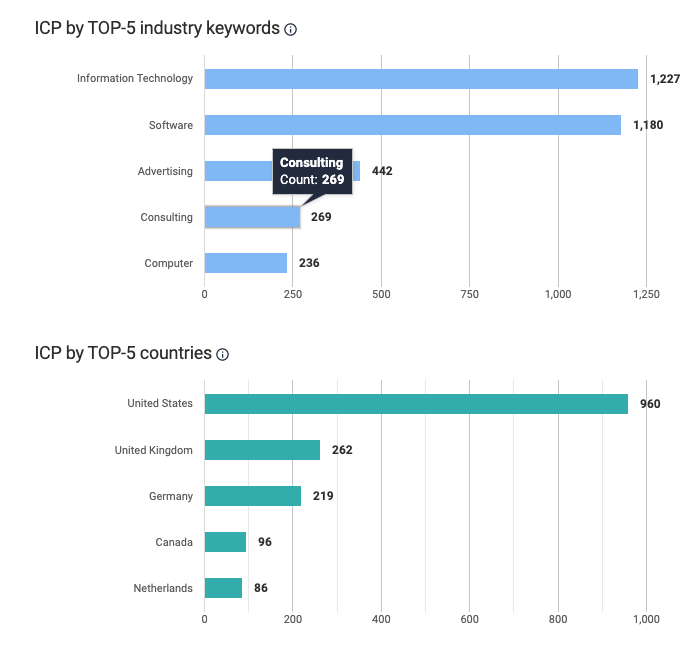
N.Rich pulls in CRM opportunity data to learn what your best customers look like, then scores new accounts against that pattern. Target lists can be built quickly using filters such as industry, employee count, and tech stack.
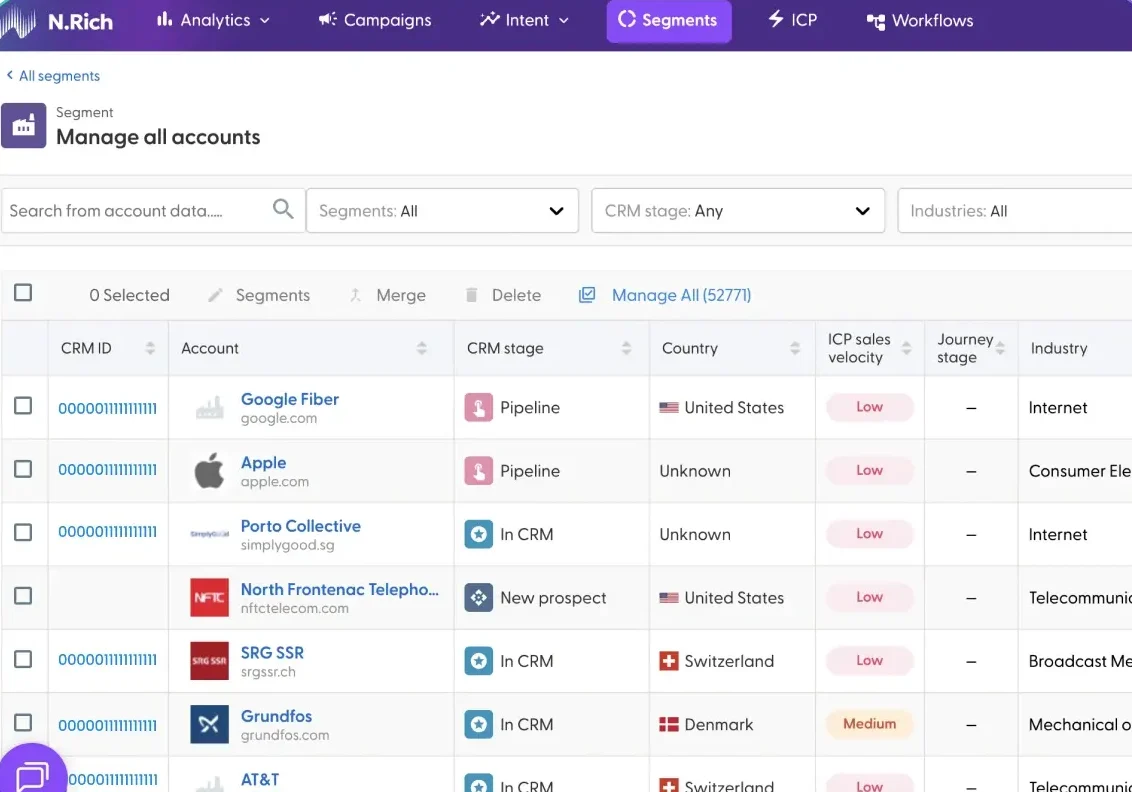
The idea is to move beyond gut feel account picks, although results still depend on CRM data quality.
Intent Data & Account Scoring
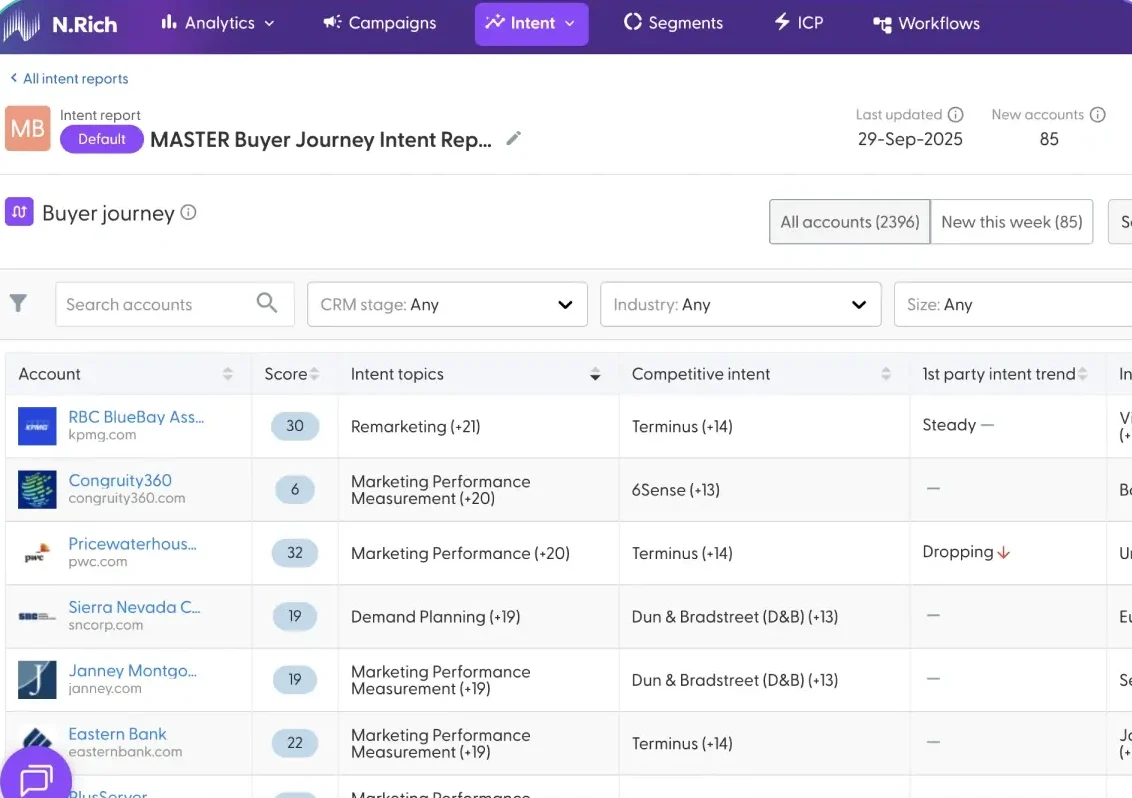
N.Rich blends first party signals (site visits, ad engagement) with third party intent feeds to highlight accounts researching key topics. Accounts receive intent scores so sales and marketing can focus on those showing the strongest, consent-based interest, while topic data syncs into your CRM.
Account-Based Advertising
N.Rich ships with a built-in DSP to run programmatic display to target accounts, supporting native and video formats.
You can connect LinkedIn Ads to keep display and LinkedIn campaigns aligned, and reviewers note a simple campaign builder with bulk creatives and A/B tests.
Analytics & Opportunity Attribution
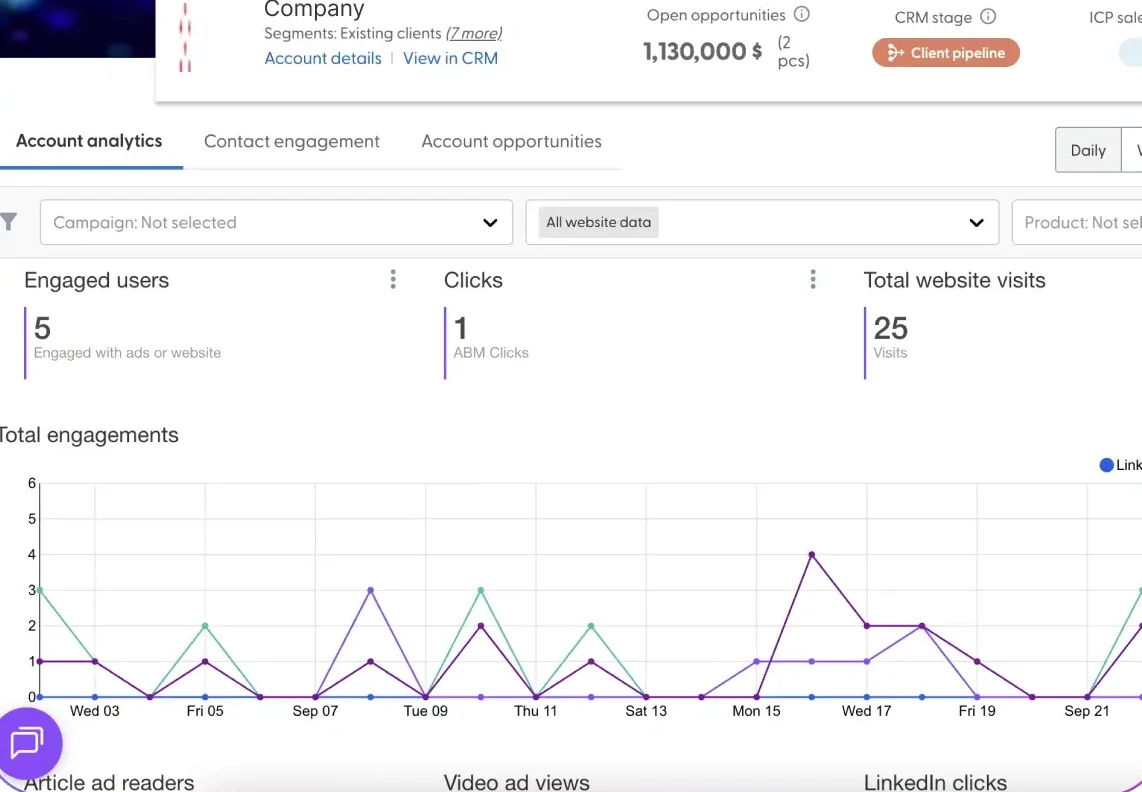
N.Rich provides account-level analytics so you can see how engagement connects to pipeline and revenue. Its Opportunity Attribution dashboard links impressions, clicks, and visits with opportunities and closed deals.
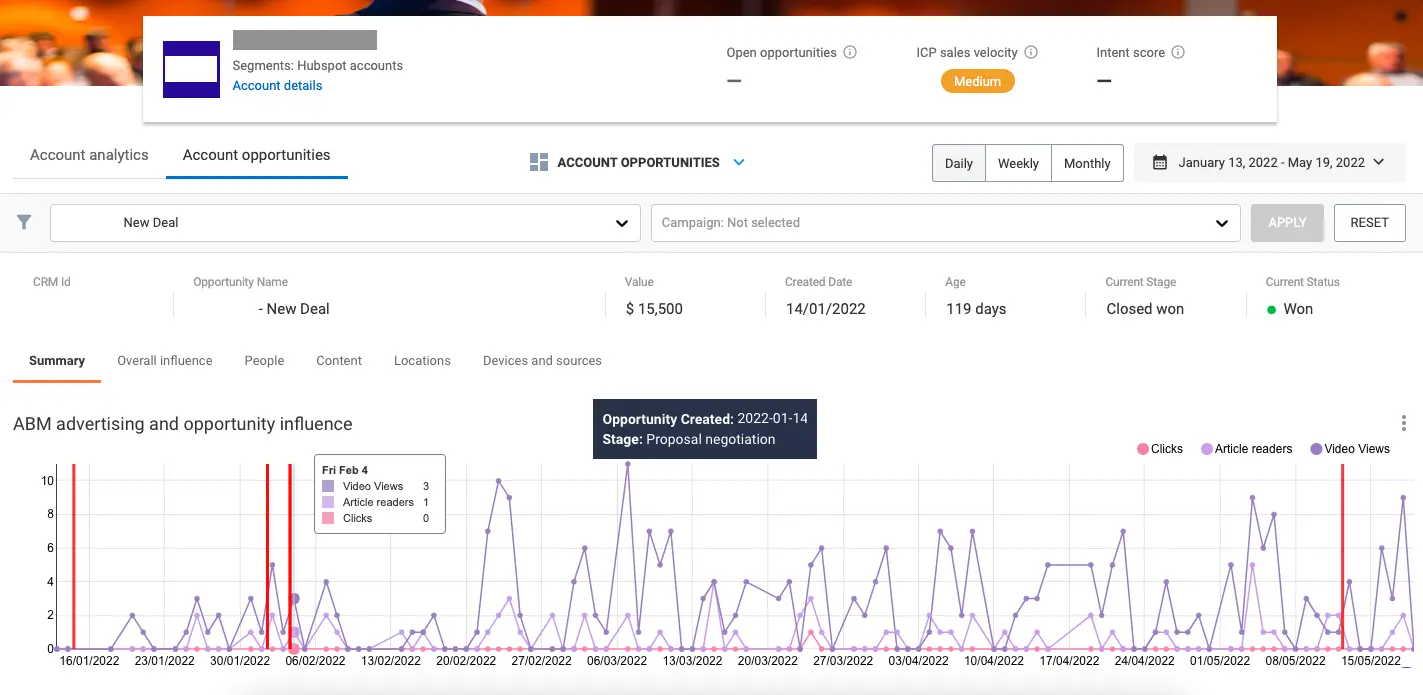

The system also calculates an ICP Sales Velocity Score for each account, with data sync back to the CRM on higher tiers.
Integrations & Data Enrichment
N.Rich integrates with the main CRMs and marketing tools. Native connectors exist for Salesforce, HubSpot (Marketing and Sales Hub), and LinkedIn (Marketing Solutions and Sales Navigator), letting you pull CRM data for segmentation and push back engagement, topics, and scores. Higher tiers add firmographic and technographic enrichment.
N.Rich Pricing: How Much Does It Cost?

N.Rich has tiered pricing tied to team size and ABM maturity. All plans aim to turn intent data into deals.
LITE: Starting at $10,320/year + $1,050 One-Time Onboarding Fee
For smaller teams starting with intent-driven ABM.
Includes 1 intent report, 10 topics, 1 marketing seat, 3 sales seats, 1 N.Rich account, 1 ABM campaign, chat support, plus:
- Intent scoring
- Unlimited firmographic and technographic data
- Website visitor identification
- Basic account analytics and alerts
GROWTH: Starting at $23,800/year
For teams scaling ABM and needing closer sales and marketing alignment.
Includes everything in LITE plus:
- More intent reports and topics
- More marketing seats and unlimited sales seats
- CRM and MAP integrations
- Opportunity attribution and more ABM campaigns
- Dedicated Customer Success Manager
ENTERPRISE: Custom Pricing
For global, mature ABM programs with advanced orchestration needs.
Includes everything in GROWTH plus:
- Unlimited intent reports and higher topic limits
- Unlimited users and multiple N.Rich accounts
- Dynamic ICP Builder and open API
- Automated workflows and strategic consulting
All plans benefit from N.Rich’s data depth and native ABM orchestration, but you still need to talk to sales for exact quotes.
Note: because N.Rich starts above $10K per year, ZenABM often looks leaner for LinkedIn first teams, starting at ~$59/month, with the top tier still under $6K per year. You still get core LinkedIn ABM essentials: account-level ad engagement tracking, account scoring, ABM stage tracking, hot account routing, bi-directional CRM sync, custom webhooks, qualitative intent, and plug-and-play ROI dashboards.

User Impressions and Reviews
N.Rich scores 4.7 out of 5 on G2 (around 99 reviews), which suggests customers are broadly satisfied.
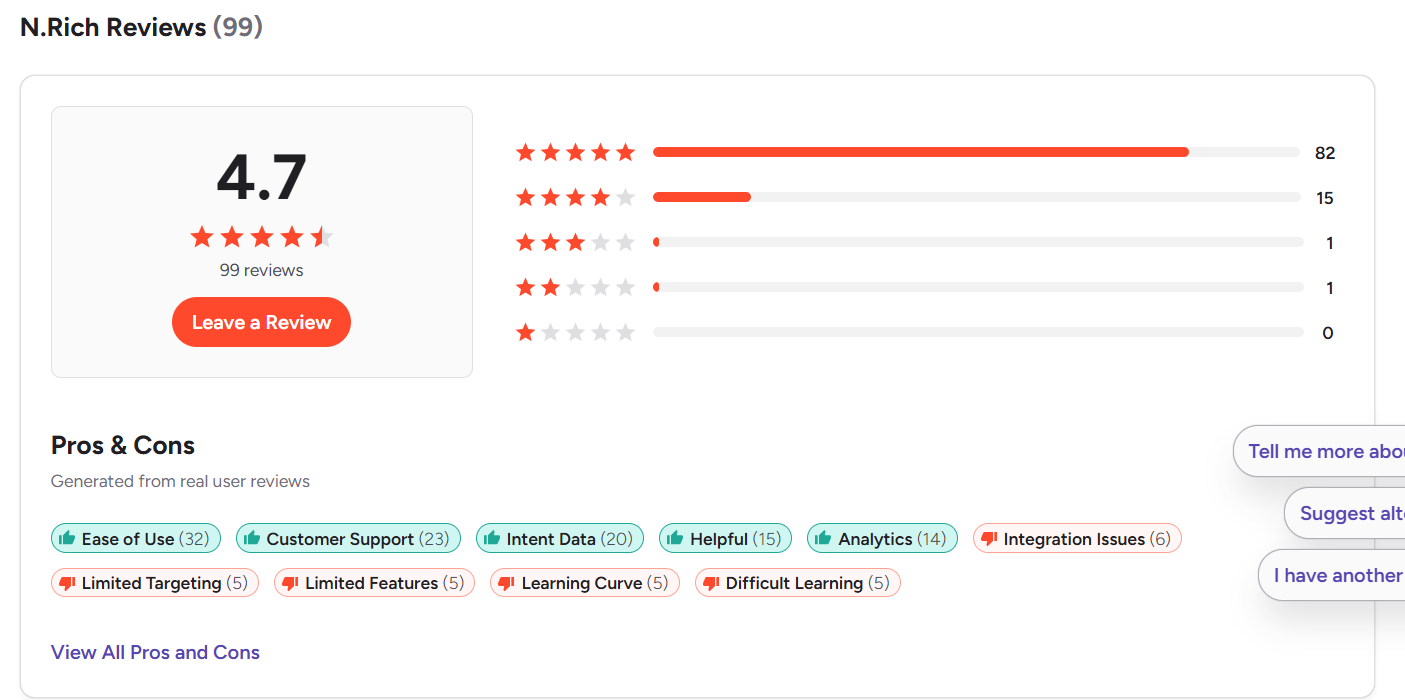
Across G2, TrustRadius, Reddit, and similar sources, a few themes show up.
Pros (According to Users)
- Support that shows up: Reviewers often describe N.Rich’s support as responsive and proactive, with regular check ins that are not just upsells.
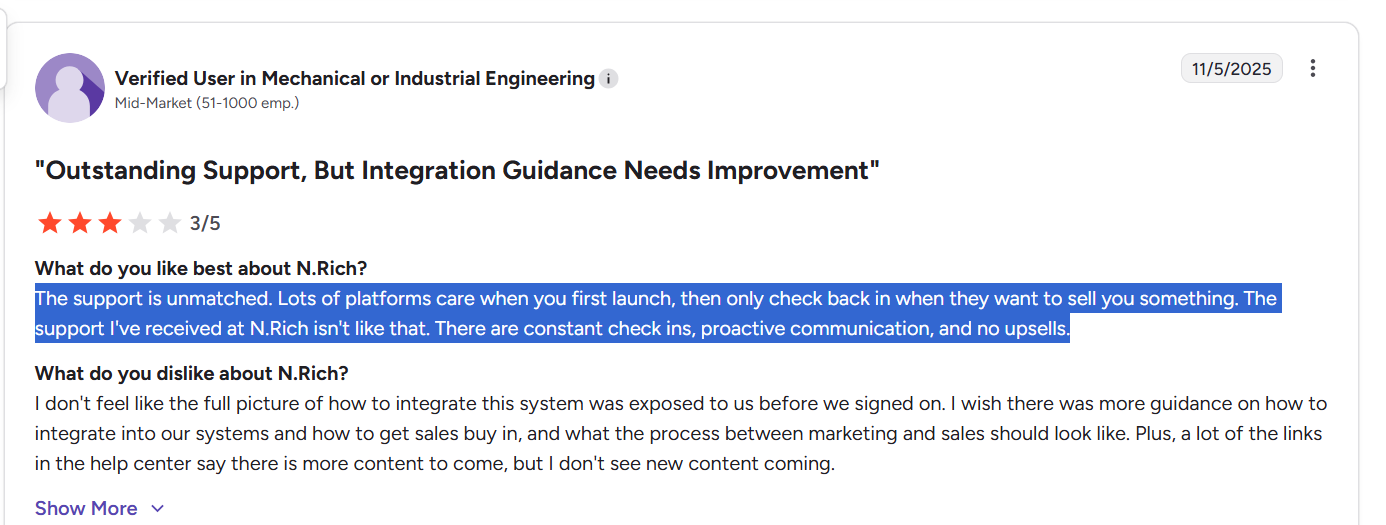
- Usable once configured: Many call it easy and even “fun” to use once lists, reports, and campaigns are in place.
- Strong intent and targeting: Users praise the quality of intent and account selection for focusing ad spend on high value accounts.
Cons (According to Users)
- Setup takes work: Onboarding, data mapping, and reporting usually need ops involvement.
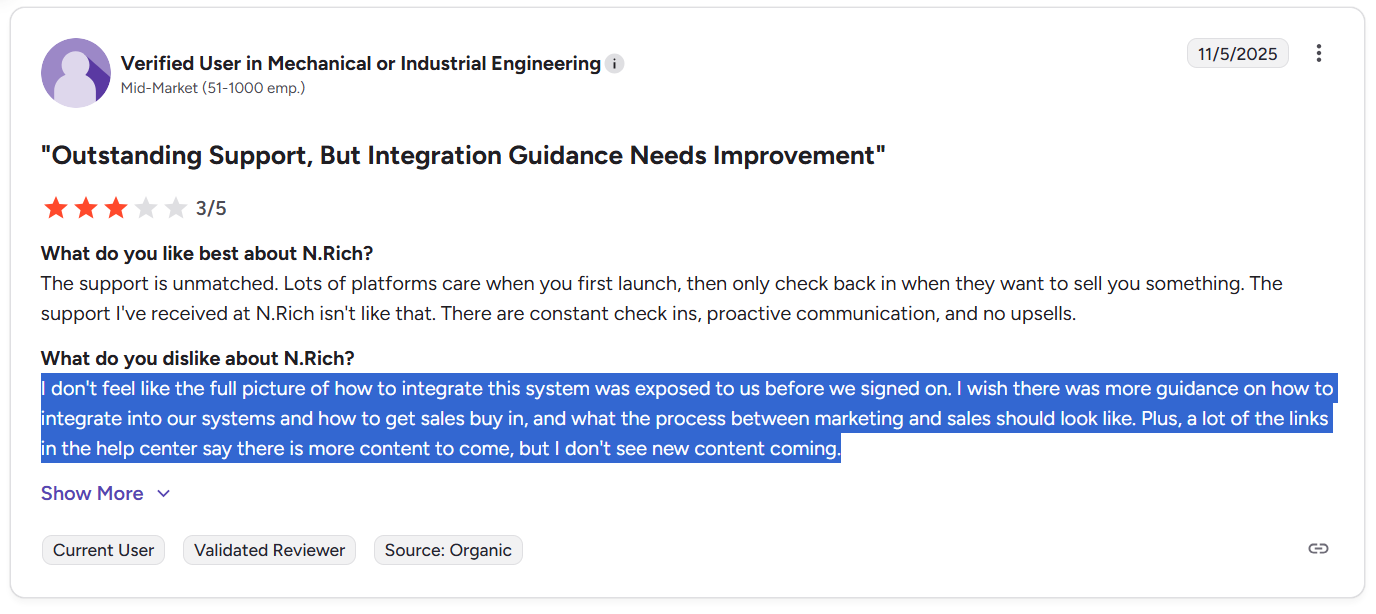
- Integrations need clearer guidance: Some reviewers report integration surprises and wish the full picture had been clearer before signing.
- Feature gaps: A few users mention limits around ad copy, session timeouts, or glitches.
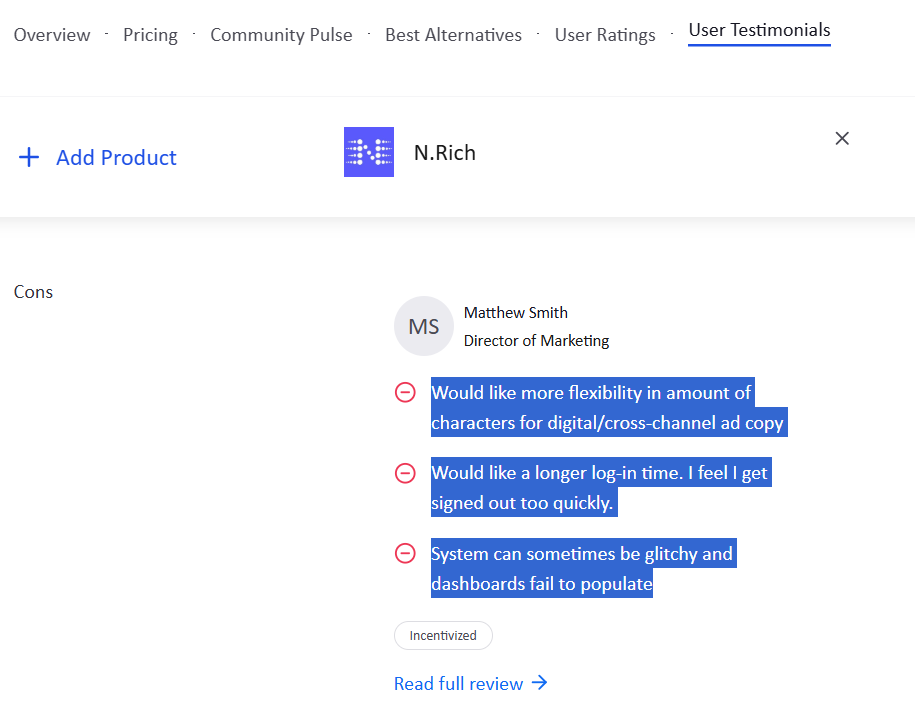
Linklo Overview: Key Features, Pricing, and Reviews
Linklo bills itself as a LinkedIn Ads optimization platform built for account-based marketing-like precision.
It lets you schedule LinkedIn ads, balance ad reach across target accounts, integrate “intent” timing, and generally squeeze more efficiency from LinkedIn’s notoriously expensive ad channel.
Let’s take a deeper look at its key features and also discuss its pricing and reviews.
Key Features of Linklo
Linklo is laser-focused on LinkedIn Ads.
In fact, that’s the only advertising channel it manages.
The platform is essentially a power-user layer on top of LinkedIn Campaign Manager, addressing features LinkedIn itself lacks.
Its core offerings:
Ad Scheduling & Dayparting
Perhaps Linklo’s flagship capability is automated scheduling of LinkedIn ads.
LinkedIn’s own ad platform infamously does not let you daypart or automatically pause campaigns on a schedule.
Linklo fills this gap by letting you set precise times for campaigns to run (e.g. only weekdays 8 am-8 pm).
The idea is to focus budget “where buyers actually engage” – e.g. during business hours, instead of frittering away spend at 2 am.
Company Flow™ for ABM Sequences
Linklo provides proprietary Company Flow™ feature to “balance reach/frequency and orchestrate ABM-style sequences” across your LinkedIn campaigns.
In plainer terms, this means Linklo tries to ensure your target accounts each see your ads in a balanced way.
Instead of LinkedIn’s algorithm dumping impressions into only a handful of accounts, Linklo’s Company Flow feature evens out the delivery so one company doesn’t gobble most of your impressions.
Company Flow also implies the ability to sequence ads, meaning you could show Ad A to an account first, then Ad B later as a follow-up.
However, let’s be clear: this is within LinkedIn only.
Linklo isn’t coordinating email touches or Sales Navigator InMails or any off-LinkedIn channels in those sequences.
It’s not a full orchestration platform like, say, Terminus (which coordinates ads, email, web personalization, etc.).
Data and Intent Features
Linklo doesn’t provide any third-party intent data from sources like Bombora, etc.
It assumes you already know your target account list and focuses on delivering ads to them efficiently.
The closest thing to “intent” in Linklo’s toolkit is its use of engagement timing data.
By analyzing when your audience tends to engage on LinkedIn, Linklo can schedule ads during those intent-rich windows (e.g. if decision-makers engage more on Tuesday mornings, it will concentrate spend there).
This is useful, but it’s a far cry from the qualitative intent data that ABM platforms offer.
Pro Tip: Linklo provides no kind of intent data. Other ABM suites like 6sense, RollWorks, etc., provide intent data, but I don’t even prefer that. Third-party intent looks exciting until you realize it’s stitched together from mystery browsing data and hope. It tells you what a single contact might be googling, not what an entire buying committee actually cares about. ZenABM skips the guesswork by giving you first-party company-level intent straight from your own LinkedIn ads. You see which accounts engaged with which themes, which feature groups they reacted to, and how their interest changes over time.

Userpilot, using ZenABM, built their whole ABM campaign structure around this first-party company-buyer’s intent obtained from LinkedIn ads instead of third-party tools:
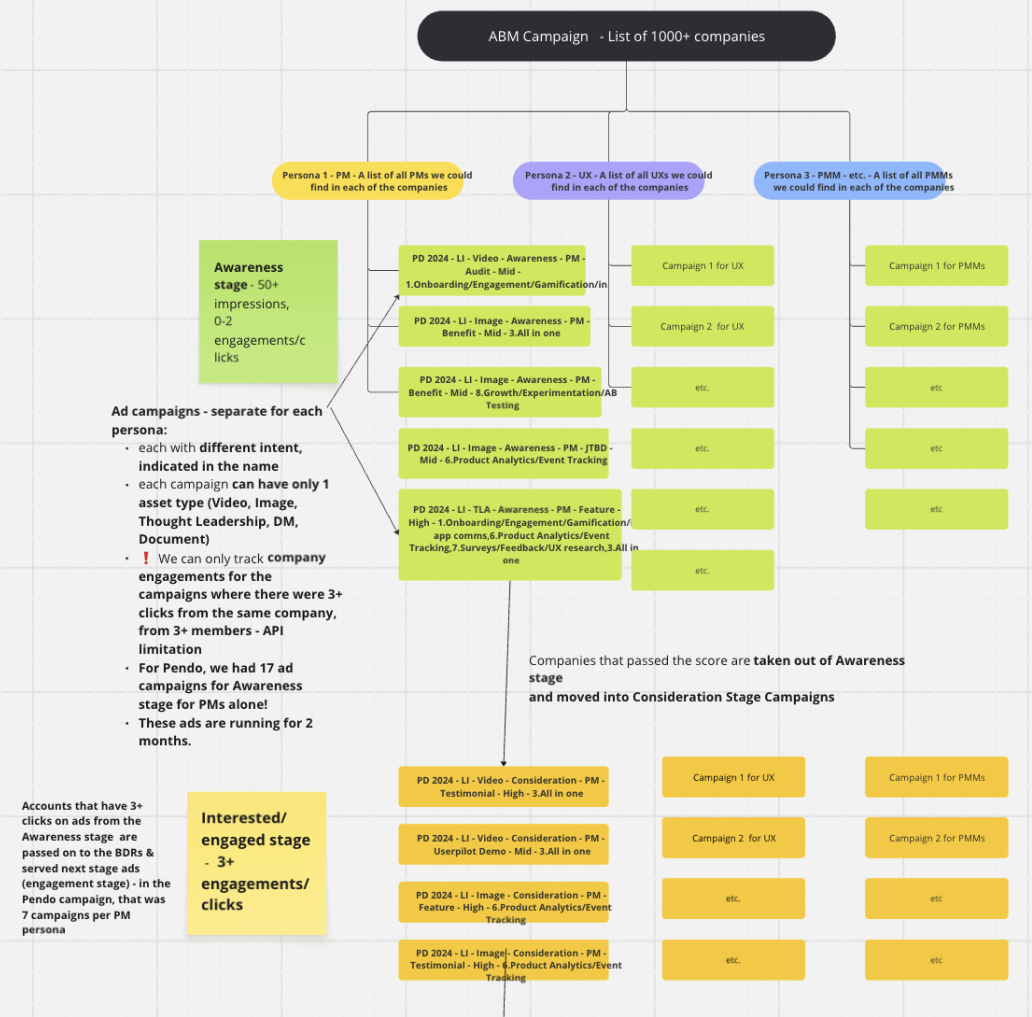
CRM and Marketing Automation Integrations
Linklo, being a lean LinkedIn-focused tool, currently has no native CRM or marketing automation integration.
The platform seems to operate mostly within its own dashboard on top of LinkedIn.
You use Linklo to adjust campaigns, and of course, your leads still flow into LinkedIn’s native lead gen forms or your CRM via LinkedIn’s connectors, but Linklo isn’t pushing account-level insights into your CRM.
ZenABM, on the contrary, does provide bi-directional CRM sync:
- It pushes LinkedIn ad engagement metrics as company properties to your CRM:
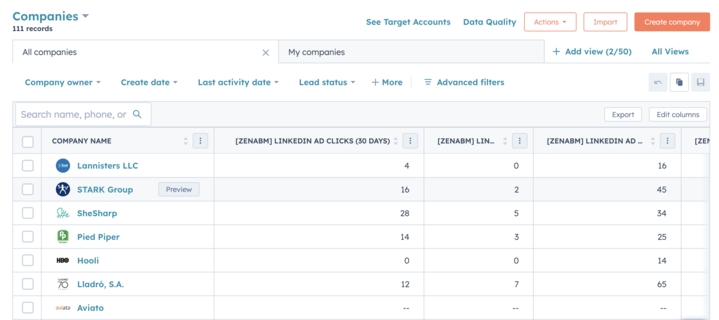
LinkedIn ad data pushed to company lists in the HubSpot CRM using ZenABM - It matches ad-engaged companies to the deals in your CRM for LinkedIn ads ROI attribution.
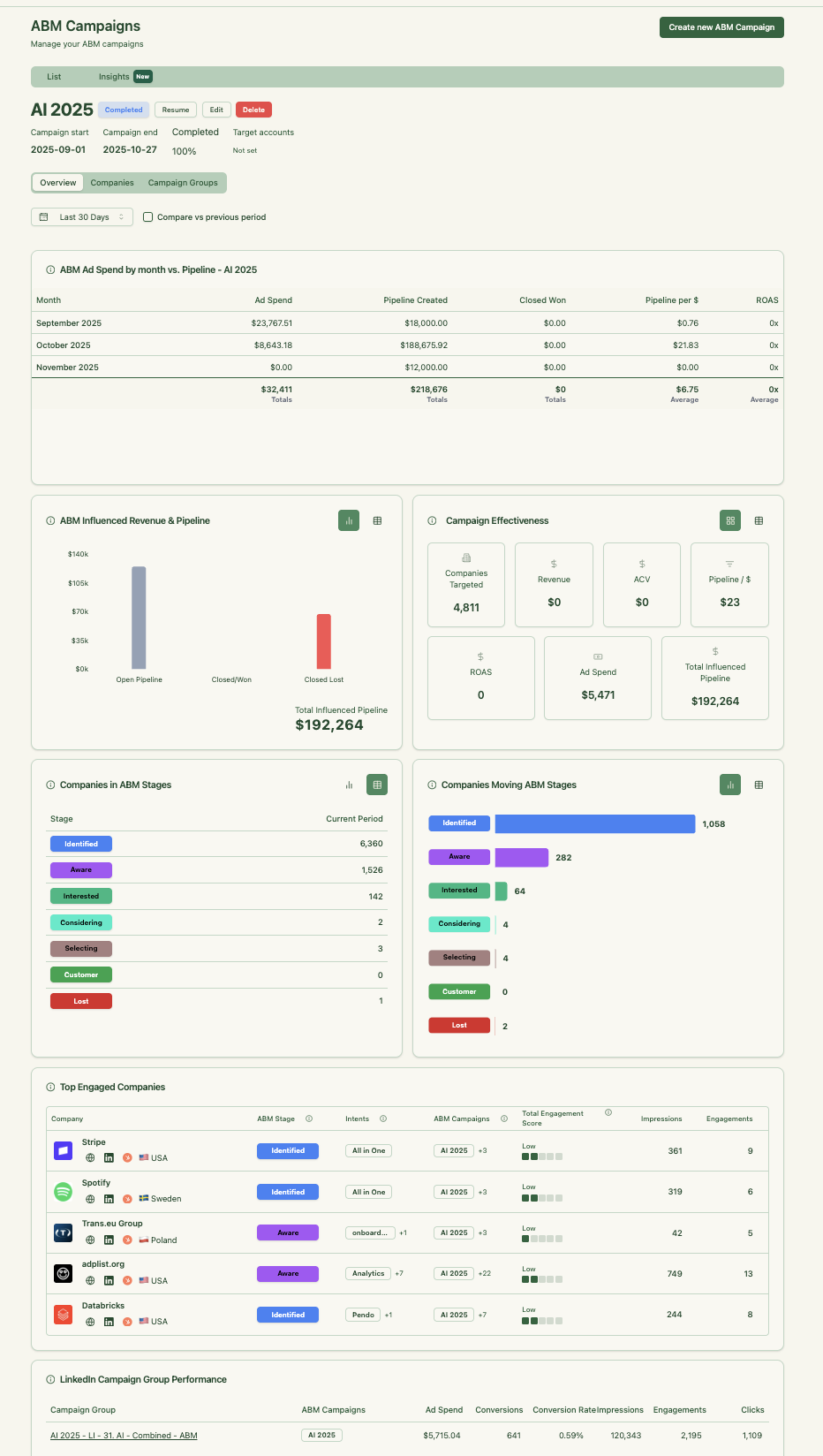
ZenABM Campaign analytics 
ZenABM dashboard showing company-level ad engagement data per campaign by pulling first-party intent signals from the LinkedIn API
Personalization Capabilities
Personalization in ABM usually means tailoring messaging or creatives to each account or segment.
Linklo itself doesn’t create personalized ad content for you.
You still have to design the ads.
However, by orchestrating sequences and controlling frequency per account (via Company Flow), Linklo enables a form of personalization: you could line up different ads for different stages or industries and use Linklo to ensure each account sees the right sequence.
Linklo Pricing: How Much Does It Cost?
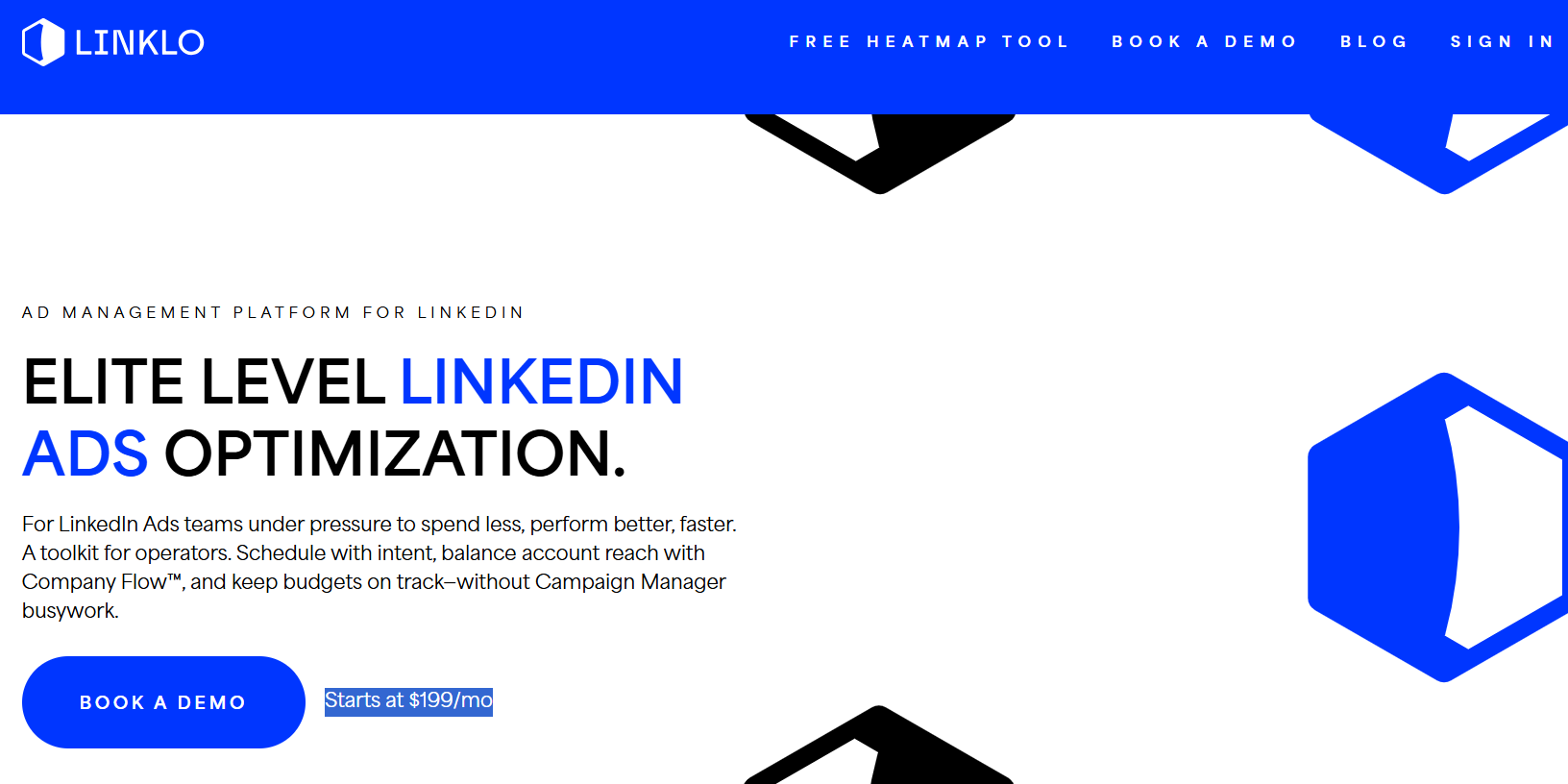
Linklo publicly advertises that it “Starts at $199/mo.”
Nothing more.
Nothing less.
Not much is available on review sites either.
That suggests a flat monthly subscription (likely for a base package), which is refreshingly transparent compared to enterprise ABM platforms that require demos just to get a quote.
At $199 a month, Linklo is positioned as a relatively affordable tool – certainly modest next to the multi-thousand-dollar contracts of full-scale ABM suites.
What do you get for $199/mo?
The details aren’t fully spelt out on the website, but presumably the base plan includes core features (scheduling, budget management, A/B testing) for one LinkedIn Ads account or a limited number of users.
It’s possible that higher spending or multiple ad accounts could require higher tiers – e.g. agencies managing many accounts might pay more, but we haven’t seen a published tier breakdown.
The “starts at” phrasing implies there are higher levels, perhaps based on ad spend or team size.
One potential concern is feature bloat relative to cost.
Linklo packs in multiple capabilities (some might say it’s bloated for just managing LinkedIn): it’s combining functions of a bid rule engine, an ad scheduler, a budget pacing tool, and a lightweight analytics tool. If your team only needs one of those features (say, just dayparting), $199 might feel steep.
Conversely, if you’ll actively use all those features, then $199 is a great value.
Linklo’s pricing, being subscription-based, also means you can cancel if it’s not delivering value.
This is important because some ABM investments are hard to back out of (annual contracts, long implementation).
Again, if you are looking for a LinkedIn ABM tool with clearer pricing, I present ZenABM, starting at just $59/month.
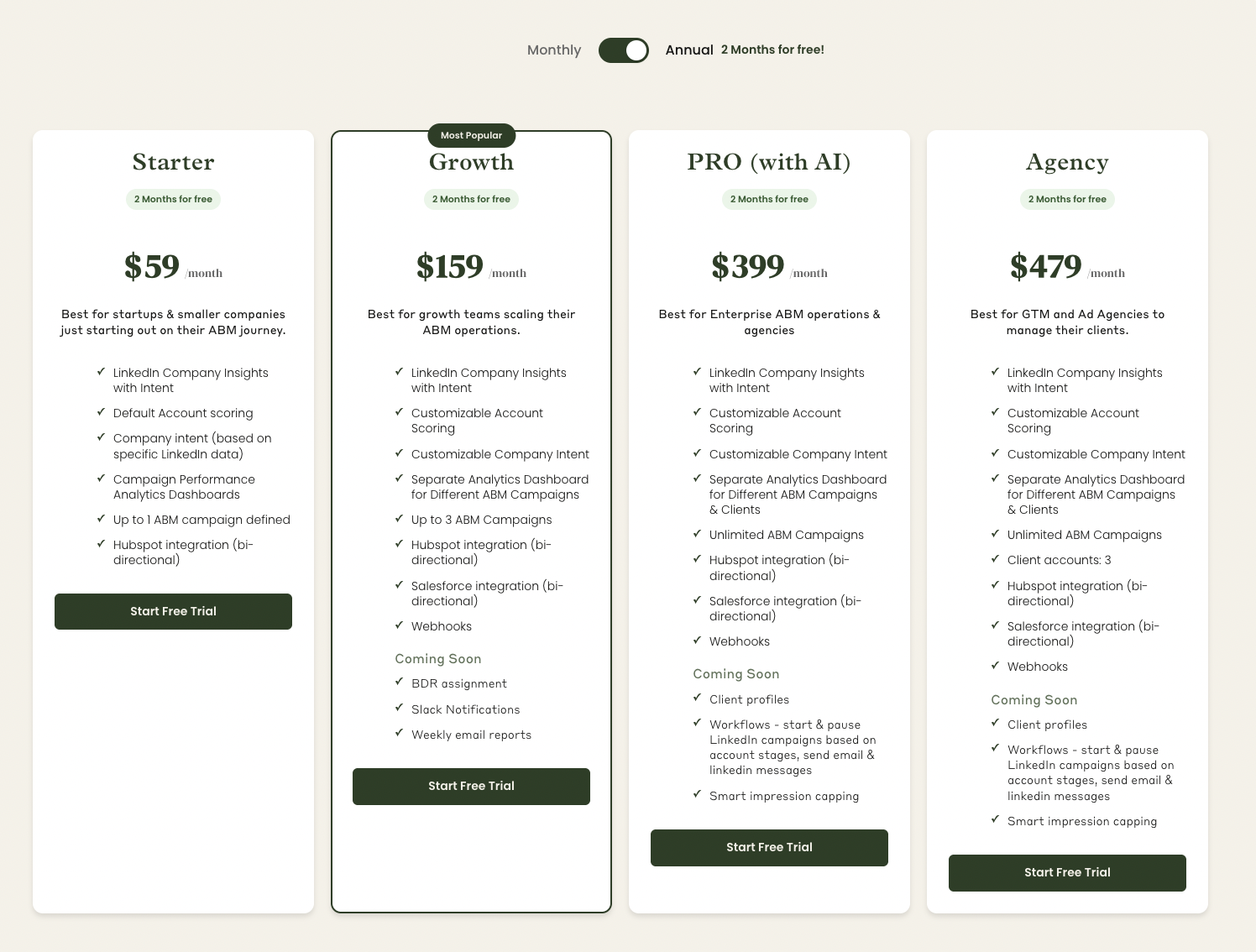
ZenABM offers account-level LinkedIn ad engagement tracking, ad engagement-to-pipeline analytics with plug-and-play dashboards, account scoring, ABM stage tracking, CRM sync, first-party qualitative intent, automated assignment of BDRs to hot accounts, custom webhooks, and ad engagement tracking at the job-title level.

User Impressions and Reviews
For a grounded view, what are actual users (or tire-kickers) saying about Linklo?
The truth is that public user sentiment is sparse.
Linklo launched in 2023 and hasn’t amassed many reviews on major platforms yet.
On G2, for example, Linklo is listed in the Social Media Advertising category but currently sits at 0 reviews.
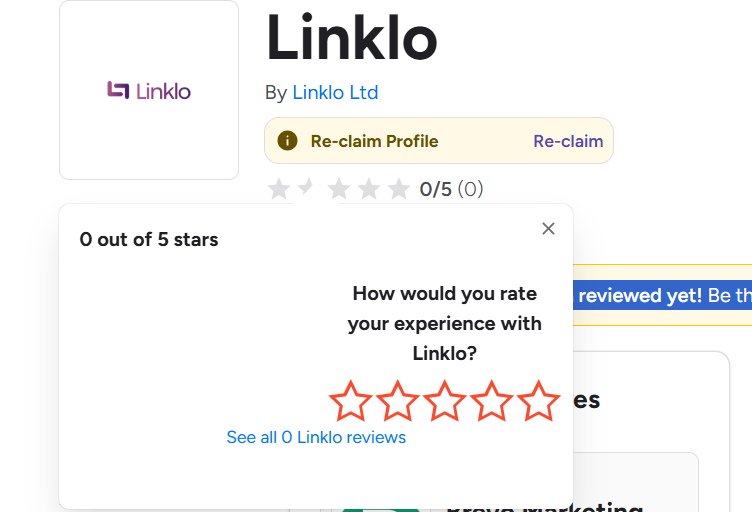
TrustRadius and other review sites similarly have no substantial data on Linklo (a TrustRadius search turned up empty as of late 2025).
On social media and forums, the chatter I did find was a mix of curiosity and cautious optimism.
On Reddit, Linklo’s name has popped up in discussions among pay-per-click and LinkedIn Ads practitioners.
In one thread about scheduling LinkedIn ads (a question born out of frustration with LinkedIn’s limitations), a user mentioned Linklo as a known solution, though they admitted they hadn’t used it yet.

N.Rich vs. Linklo: Key Differences
The key differences between N.Rich vs. Linklo are tabulated here.
| Feature category | N.Rich | Linklo | Where ZenABM fits |
|---|---|---|---|
| Core positioning | ABM execution layer built on a B2B DSP with ICP builder, intent scoring, and programmatic plus LinkedIn campaigns | LinkedIn-centric optimization and engagement platform focused on making existing campaigns more efficient | LinkedIn first ABM analytics and routing layer that can sit alongside either tool |
| Primary focus | Turn consent based intent and CRM data into targeted ads and measurable opportunities | Improve performance of LinkedIn ads with better scheduling, budgets, and account level engagement views | Reveal which companies see and engage with LinkedIn ads and how that ties to stages and revenue |
| Main capabilities | Dynamic ICP builder, target account lists, intent scoring, ABM campaigns, account analytics, opportunity attribution | LinkedIn audience tuning, campaign controls, pacing and budgeting, and practical performance reporting for target accounts | Company level engagement, ABM stages, account scoring, CRM sync, intent tagging, and ROI dashboards |
| Channels covered | Programmatic display through built in DSP plus coordination with LinkedIn Ads | Primarily LinkedIn, with focus on optimizing campaigns and targeting inside that channel | Uses LinkedIn Ads only and treats it as the main ABM channel |
| Intent model | Mix of first party engagement and third party intent topics tracked in a consent based way | Leans more on engagement and performance signals inside LinkedIn than on a broad third party intent graph | First party qualitative intent from how companies interact with themed LinkedIn campaigns |
| Account analytics and attribution | Account level analytics with opportunity attribution and ICP sales velocity scores | Account level LinkedIn engagement and campaign performance views for optimization | ABM dashboards that show account movement, pipeline per dollar, and ROAS for LinkedIn campaigns |
| Integrations | Salesforce, HubSpot, LinkedIn Marketing Solutions and Sales Navigator, with enrichment on higher tiers | Integrations focused on LinkedIn plus core CRM and marketing tools for reporting and alerts | Bi directional HubSpot sync, Salesforce on higher plans, webhooks into the rest of the stack |
| Pricing profile | Tiered plans starting above ten thousand dollars per year plus onboarding and scaling with usage | Pricing aligned to LinkedIn centric teams that want stronger control without a full DSP cost structure | Starts at $59 per month, with the top plan still under $6k per year |
| Ideal team profile | Mid market and enterprise teams that want intent driven programmatic plus LinkedIn with clear attribution | Teams that spend heavily on LinkedIn Ads and want more control and insight without running a programmatic stack | LinkedIn first ABM teams and agencies that need company level engagement, stages, and routing on a lean budget |
| Where ZenABM fits | Acts as a LinkedIn analytics and intent companion when you want precise company-level ad engagement inside the CRM | Acts as a deeper ABM layer for LinkedIn when you outgrow basic reporting and need stages and revenue attribution | Can replace heavier ABM suites when LinkedIn is the main growth channel |
N.Rich vs. Linklo: So Which Is Better for ABM?
N.Rich is usually the better pick if you want a structured, intent-led ABM engine that spans display and LinkedIn. It suits teams with clear ICP definitions, mature CRM data, and a programmatic plus LinkedIn playbook that needs attribution and velocity scoring.
Linklo is better if your performance and demand teams live inside LinkedIn all day, and you simply want tighter control, cleaner engagement views, and incremental gains from the same channel instead of another complex platform to run.
ZenABM as a LinkedIn First, First Party Lean ABM Alternative
If you mostly need first-party accuracy on LinkedIn, account scoring, ABM stages, CRM sync, and revenue attribution, a lighter option makes more sense.
This is where ZenABM comes in.
In fact, even for teams running heavy mult-channel ABM campaigns, ZenABM is vaulable due to its following unique features:
Account Level LinkedIn Engagement Tracking


ZenABM connects directly to the official LinkedIn Ads API and records account-level data for every campaign. You see which companies view and engage with your ads using first-party LinkedIn data instead of noisy IP or cookie matching. A Syft study suggests IP identification accuracy peaks around 42 percent, which is why ZenABM treats ad engagement as the primary intent signal.
Real Time Engagement Scoring & ABM Stages

ZenABM updates engagement scores continuously as accounts interact with your ads. The interface shows a full touchpoint history and lets you define custom stages such as Identified, Aware, Engaged, Interested, and Opportunity.


CRM Integration and Workflows
ZenABM syncs bi-directionally with HubSpot and adds Salesforce support on higher plans. All LinkedIn metrics can be written as company properties in your CRM.

When an account crosses your score threshold, ZenABM updates the stage and can assign a BDR automatically.

Intent Tagging and ABM Analytics
ZenABM lets you pull intent topics from LinkedIn campaigns and tag each campaign by feature, use case, or offer.
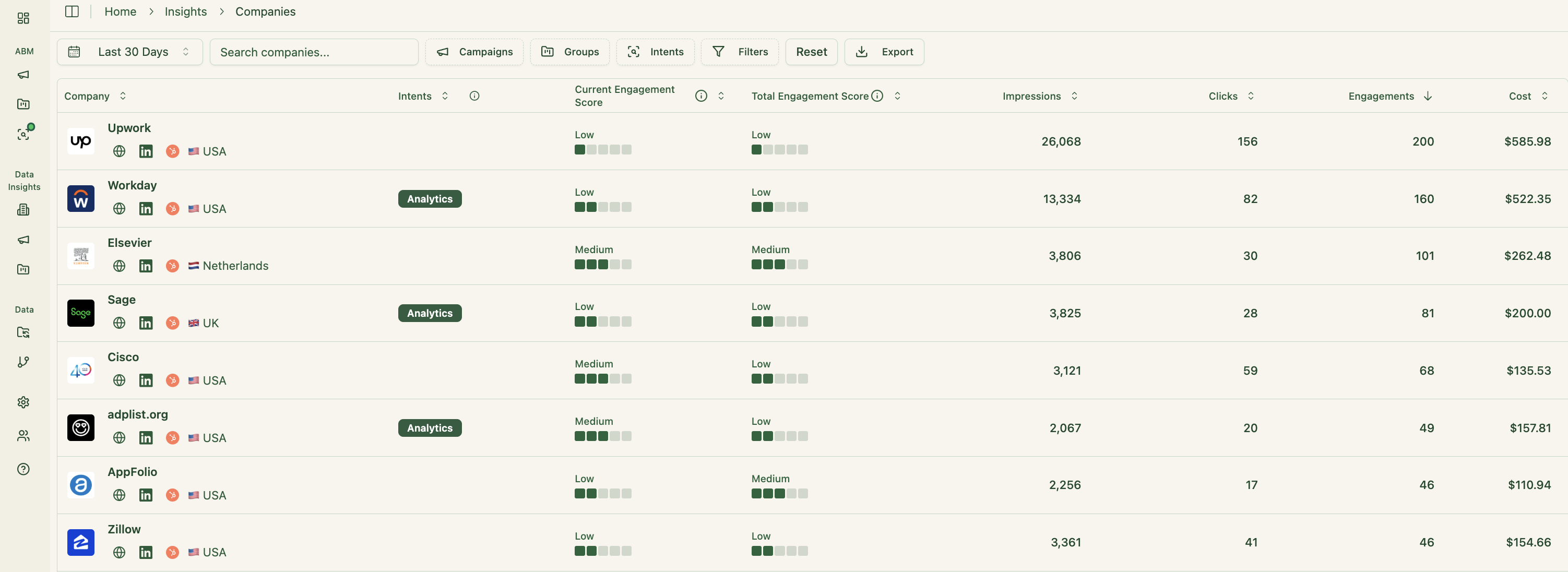
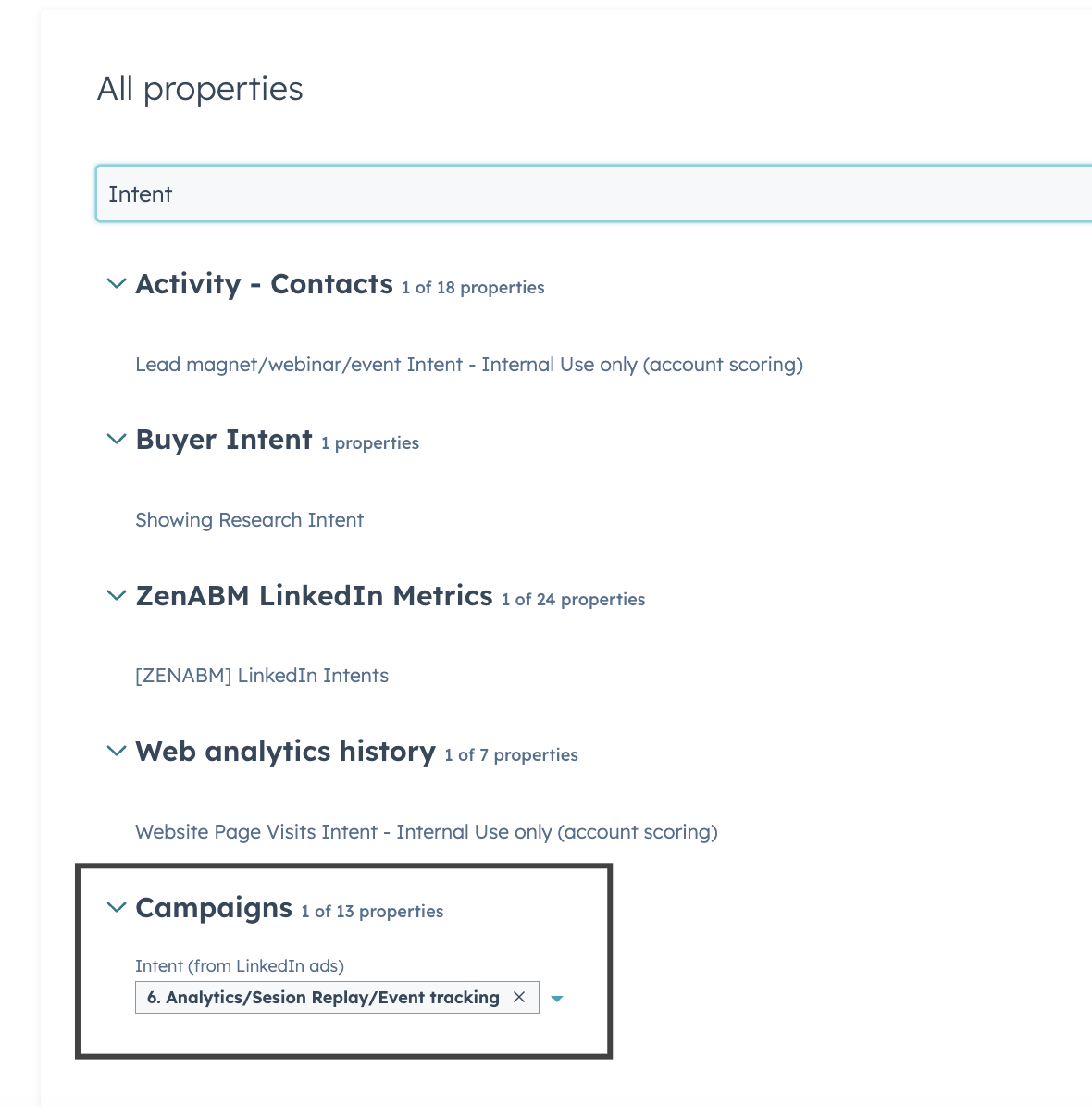
ZenABM includes ABM dashboards that tie LinkedIn ads to account engagement, stages, and revenue. You can see performance from ABM initiatives down to campaign groups and individual ads, and because ZenABM stores deal value and ad spend per company and campaign, it calculates ROAS and pipeline per dollar.
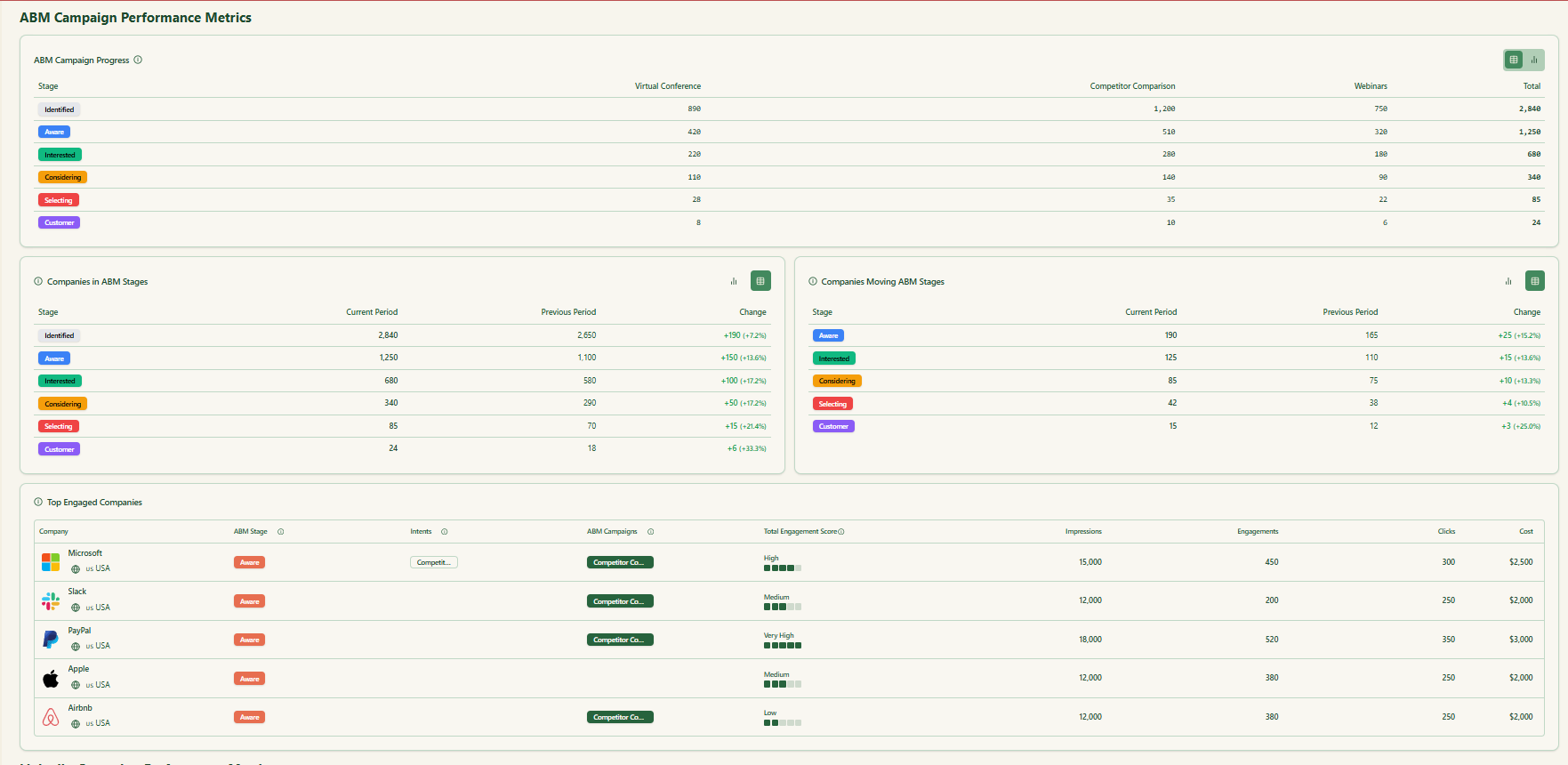

Webhooks, Job Title Analytics & Campaign Objects
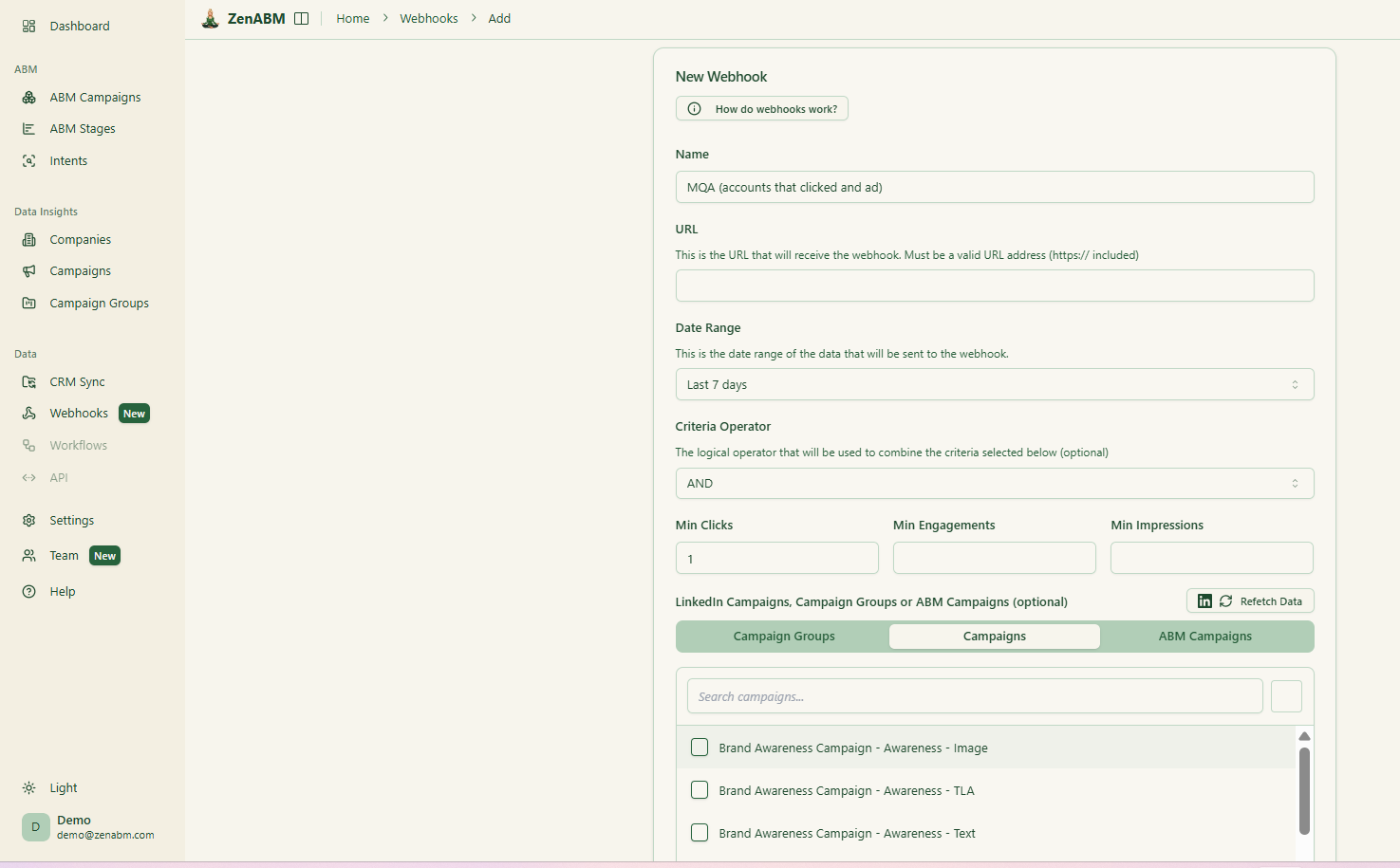
ZenABM webhooks send events into your stack for Slack alerts, enrichment flows, and other automation.
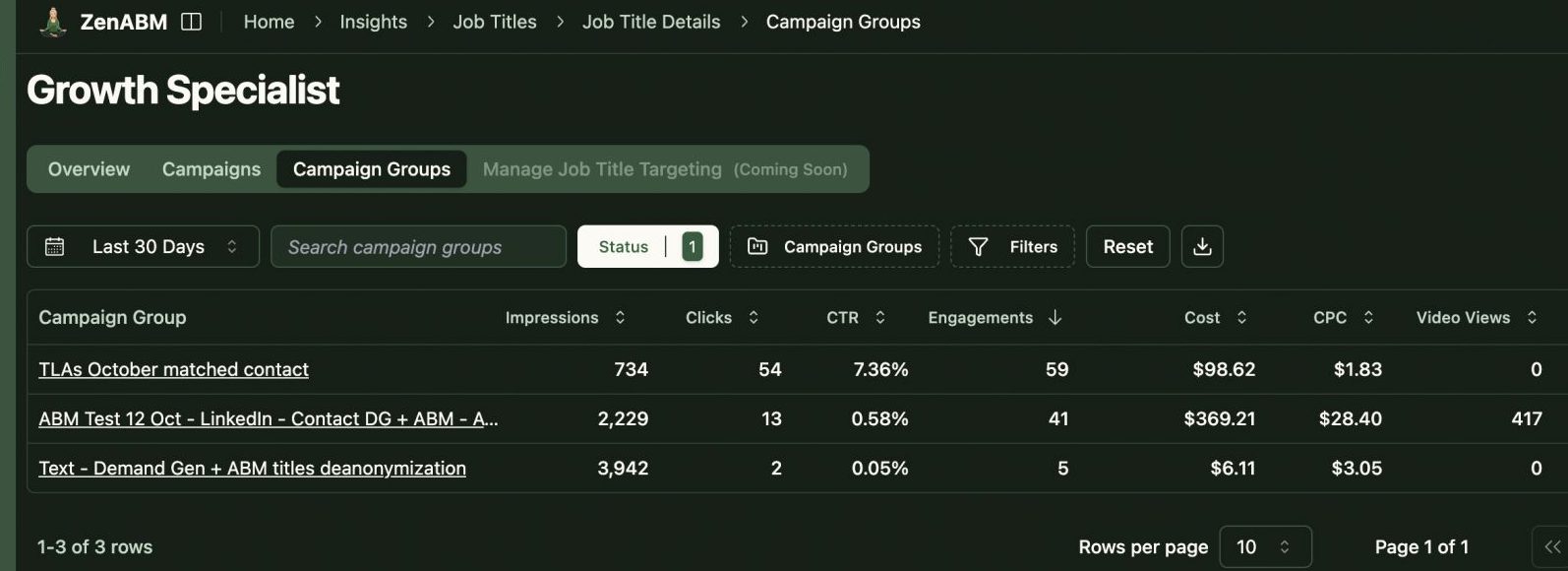
You can also group LinkedIn campaigns into ABM campaign objects to view performance across markets, personas, or creative clusters instead of juggling isolated reports.
AI Chatbot & Multi Client Workspace
ZenABM includes an AI chatbot on top of your LinkedIn API data and ABM model so you can ask questions like “Which accounts moved from Interested to Selecting last month?” or “What is my pipeline per dollar on retargeting campaigns?”.
It also supports agencies via a multi-client workspace, so you can manage several ad accounts and clients with separate ABM campaigns, dashboards, and reporting without constant account switching in Campaign Manager.
ZenABM Pricing
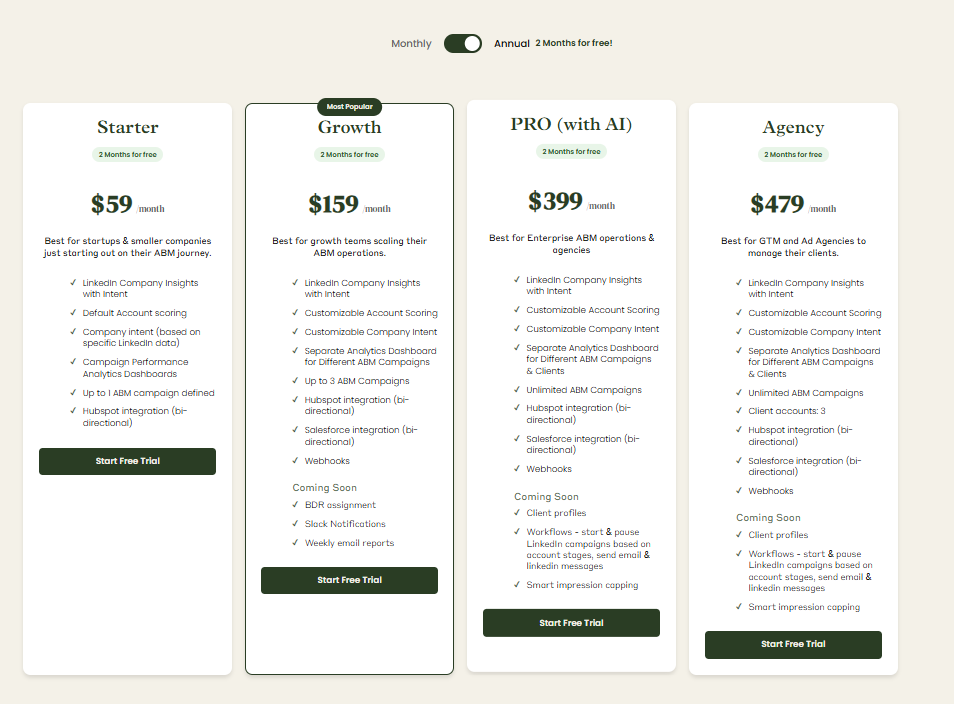
Plans start at $59/month for Starter, $159/month for Growth, $399/month for Pro (AI), and $479/month for Agency. Even the agency plan stays under $6,000 per year, with all tiers including core LinkedIn ABM capabilities. Higher tiers mainly raise limits and add Salesforce sync. All plans include a 37-day trial period.
Conclusion
N.Rich and Linklo both aim to improve how you run ABM, but they start from different ends of the problem. N.Rich is an intent driven execution layer wrapped around a DSP.
It is strongest when you want to turn consent based intent and CRM data into targeted display plus LinkedIn campaigns and then measure how those efforts influence pipeline.
Linklo is closer to a LinkedIn power tool. It suits teams that already know LinkedIn is their main paid channel and want better control over audiences, pacing, and account level engagement without adopting a full programmatic stack.
If you are running a mature, multi channel ABM program with budgets to match, mixing N.Rich with a clean data foundation can make sense. If you are primarily pushing LinkedIn as your growth engine and want to keep the stack light, Linklo is easier to justify.
For LinkedIn first teams that care more about company level engagement, first party intent, ABM stages, CRM sync, and revenue attribution than about another media execution platform, ZenABM is often the cleanest path.
You get the visibility and routing you need around LinkedIn without the cost and complexity of a heavy ABM suite, and you can still slot it alongside N.Rich or Linklo if you ever decide to keep those in your stack.

